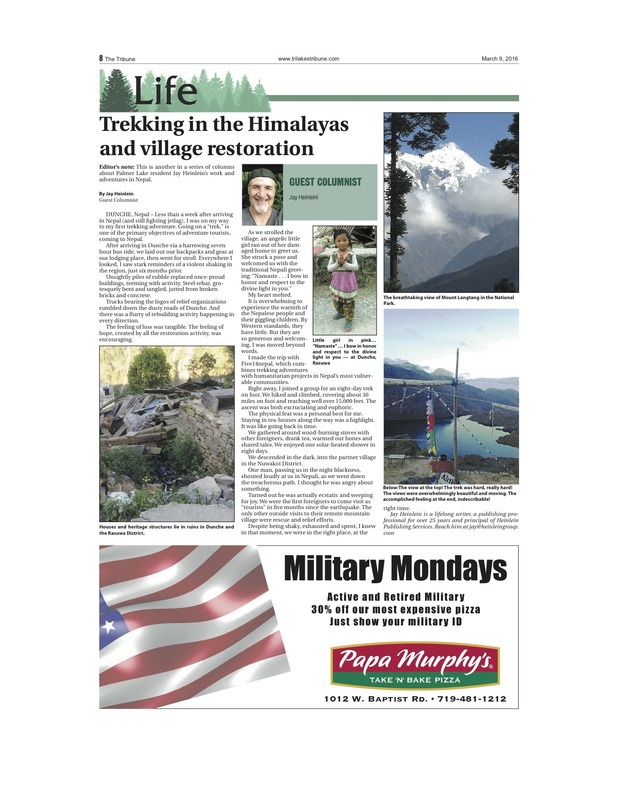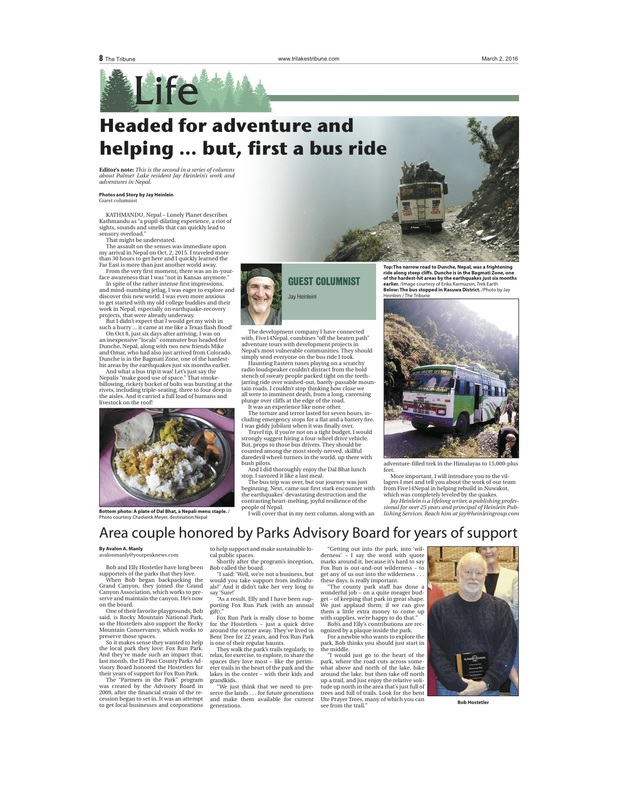Editor’s note: This is another in a series of columns about Palmer Lake resident Jay Heinlein’s work and adventures in Nepal. The Tribune of the Tri-lakes Region, Pike Peak Newspaper, Inc
By Jay Heinlein
Guest columnist
NUWAKOT DISTRICT, Nepal – The Langtang National Park-Gosainkunda high-altitude adventure trek pushed my own physical boundaries far past what I ever thought I could do.
It’s an accomplishment that fulfilled my desire to experience life on the edge and to fully engage it.
The unparalleled beauty of the Himalayas overwhelmed my senses and the conquest (which included a few heart-pounding edgy instances) produced a deep satisfaction.
Sharing the journey with gutsy, good company seared the moments into my heart among the best of my life’s dream-come-true-memories.
But my trip is more than just a personal adventure. I traveled here with Five14nepal, which combines trekking adventures with humanitarian projects in Nepal’s most vulnerable communities.
It’s work is focused on those devastated by a violent earthquake last April that killed 8,000, injured 21,000, triggered avalanches on Mount Everest, destroyed entire villages and left hundreds of thousands homeless.
On the fifth day of our trek, we descended, at night, into the original Five14 partner village, in the Nuwakot District.
The partnership with the villages of Nuwakot began with a simple helping visit by a group of adventure tourists who had hiked into “land of the “Red Panda.”
Their desire was to experience the magic of the densely forested green peaks, and hoped to catch of glimpse of the elusive panda. In the process, they forged lasting friendships by bringing much needed help via several impromptu medical clinics in area villages.
But there are problems in Nepal than rebuilding from the earthquake. There is also a darker history of its underworld sex industry, slave labor and human trafficking. Women and children in the mountain villages are particularly vulnerable to exploitation.
Volunteer education and development projects create empowering, sustainable, income options to see improved lives and futures.
On our first night in the village, we had a traditional Dal Bhat dinner and conversation, with the chief and his wife, on the dirt floor of their humble home. The warm hospitality of the Nepalis is disarming. Only the hardest of souls could not immediately love them.
Village men set up our campsite and treated us with full-sized, luxurious mattresses, uncommon for camping. We retired to our tents physically spent but glowing with inspiration from our trek and the welcoming meal.
The next morning, we tried to loosen our sore legs, splashed water on our faces, and went to work on demolition of the village’s community and training center, built just four years prior. It had been irreparably damaged by the quake and aftershocks that destroyed the whole village.
We were joined in the labor by the chief and a very enthusiastic young villager. Honestly, I took a lot of breaks that first day. I could barely walk. But dust flew, timbers and rocks were removed by hand, and after three days, the center had been leveled.
Before we left the village, we were adorned and blessed, by the chief’s wife, with khata scarves to wish us well on our journey.
During our four-hour hike out down the mountain, we were refreshed by a wilderness rain shower. It was fitting. I felt baptized into the broadened perspective of the fulfillment created by giving and contributing.
Our efforts were followed up by volunteer teams who retraced our steps in the succeeding months.
As of the end of February, there are now 20 new structures in various stages of completion including new homes, home-stay businesses, a school, medical facility, and the new community center.
We’re living the philosophy: “Adventure is about much more than an adrenaline-rush, it’s about changing the world.”
Jay Heinlein is a lifelong writer, a publishing professional for over 25 years and principal of Heinlein Publishing Services. Reach him at [email protected]


